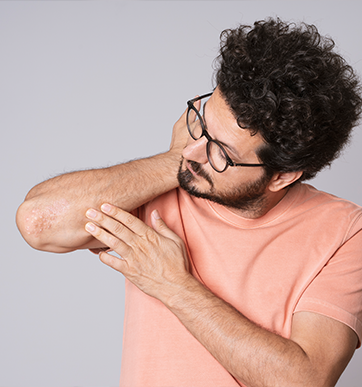
Psoriasis or Something Else? Here’s How to Tell
Are you being rash about self-diagnosing a rash? Could psoriasis really be what that rash is about? Psoriasis Awareness Month is now here, and your board-certified dermatologists at California Skin Institute are here for it. We want to help make you aware of psoriasis — just in case, right?
What is Psoriasis?
Psoriasis can look like a lot of other skin conditions. However, unlike psoriasis, most of those other skin conditions can be treated, some with OTC products, and go away. Psoriasis, on the other hand, won’t go away. It’s an immune-mediated disease. That means part of the body’s immune system becomes overactive and can disrupt normal functions of body systems. Psoriasis is not contagious, but anyone can get it. About 7.5 million men, women and children in the U.S. have it.
How Does Psoriasis Work?
Psoriasis happens when your immune system switches your skin cell turnover cycle to fast forward. Typically, new skin cells form and shed in a month. With psoriasis, skin cells turn over in only three or four days. But instead of shedding, the skin cells pile up and cause a kind of skin cell traffic jam on the surface of your skin. The resulting red patches topped with silvery gray plaques — scales of dead skin cells — may appear on any part of the body, although they mostly appear on knees, elbows and the scalp.
Psoriasis vs. Eczema
Psoriasis and eczema are both going to be itchy. Very itchy. But psoriasis also stings, like a bite from an insect. That’s a key difference. Both may appear similar, but skin inflamed by psoriasis can appear redder and thicker than skin inflamed by eczema. It may take a trained board-certified dermatologist’s eye or biopsy to tell the difference.
Both conditions can flare up in similar places on the body — elbows, knees, scalp etc. — but psoriasis may also appear on toenails, fingernails, lips and eyelids. Although they share many similar triggers, including allergens, eczema is more likely to be triggered by an allergic reaction to something like detergent or pollen, while psoriasis flareups can result from illness such as strep throat or a skin injury such as a scratch. Stress and depression can also affect psoriasis.
Psoriasis vs. Seborrheic Dermatitis
Another contender among psoriasis-lookalike conditions is seborrheic dermatitis. A key difference is oil — sebum to be exact, the oily substance produced by your skin to protect it. But when too much sebum gets produced, it can clog the pores and bad things can happen. One of these is seborrheic dermatitis (“seborrheic” coming from the word “sebum”).
Seborrheic dermatitis strikes in spots where your skin secretes the most sebum. It often occurs on the scalp with resulting dandruff, but it also can strike oily areas on the face — primarily the eyebrows and nose — as well as the upper chest and back. Seborrheic dermatitis feels greasy to the touch.
Psoriasis, in contrast, is dry. Any patches and flakes will be dry and silvery, while those of seborrheic dermatitis will be yellowish white and oily. Both conditions can itch, but only psoriasis will sting.
There is also a condition called sebopsoriasis where seborrheic dermatitis and psoriasis overlap. In that case, you will likely have the symptoms of both.
Psoriasis vs. Ringworm
Ringworm is another condition that may somewhat resemble psoriasis. Lots of little red bumps that itch? Yes, for both diseases. Both psoriasis and ringworm can emerge in similar areas of the body, including the groin. But the similarities may end there. Psoriasis, as we’ve explored above, is an immune-mediated disease, perhaps hereditary. Ringworm is a fungal infection.
Ringworm is also highly contagious, unlike psoriasis. Anyone can get ringworm from anywhere. You can get it from direct contact with another person, an animal or a contaminated object. The fungi that cause this infection can live on skin and all kinds of surfaces, including household items like clothing, towels and bedding.
A telltale sign that it’s ringworm and not psoriasis is the raised itchy bumps form a circle that looks like a coiled worm. Hence the name.
Most significant of all, ringworm can be successfully treated in a few days, often with an OTC medication. An antifungal cream that contains clotrimazole or terbinafine is probably your best bet. If it doesn’t improve, it’s time to see your California Skin Institute board-certified dermatologist and get a proper diagnosis.
Psoriasis vs. Skin Cancer
A scaly growth that bleeds or develops a crust could be skin cancer, particularly squamous cell carcinoma. This and other types of skin cancer, such as basal cell carcinoma, most often appear on the nose, forehead, ears, lower lip, hands and other sun-exposed areas of the body also prone to psoriasis outbreak. Skin cancer is often curable if caught and treated early. If not, it can be fatal. Here again, the most prudent course of action is a medical diagnosis by a board-certified dermatologist.
Psoriatic Arthritis
Inflammation caused by psoriasis could affect other organs and tissues in the body and trigger other health conditions. One manifestation of this is psoriatic arthritis. Like common arthritis, this can cause swelling, stiffness and pain in the joints and areas around the joints. But if it’s psoriatic arthritis, it’s important to treat it as soon as possible to help avoid permanent joint damage.
The Takeaway
Besides those highlighted here, there are other conditions that may be confused with psoriasis including rosacea and keratosis pilaris. Here’s the takeaway: An inflamed patch that is also bumpy, scaly, itchy and maybe painful is not business as usual for your skin. Psoriasis management requires more intensive treatment than some other skin conditions that have a similar appearance. Even if it turns out to not be psoriasis, whatever it may be needs diagnosis and treatment, too. It’s also worth noting that your medical insurance will likely cover costs involved in diagnosing and treating it. Contact California Skin Institute to request an appointment with a board-certified dermatologist near you.



 / 291 Reviews
/ 291 Reviews